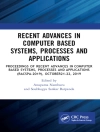Reviews the new High Efficiency Video Coding (HEVC) standard and advancements in adaptive streaming technologies for use in broadband networks and the Internet
This book describes next-generation video coding and streaming technologies with a comparative assessment of the strengths and weaknesses. Specific emphasis is placed on the H.265/HEVC video coding standard and adaptive bit rate video streaming. In addition to evaluating the impact of different types of video content and powerful feature sets on HEVC coding efficiency, the text provides an in-depth study on the practical performance of popular adaptive streaming platforms and useful tips for streaming optimization. Readers will learn of new over-the-top (OTT) online TV advancements, the direction of the broadband telecommunications industry, and the latest developments that will help keep implementation costs down and maximize return on infrastructure investment.
* Reviews the emerging High Efficiency Video Coding (HEVC) standard and compares its coding performance with the MPEG-4 Advanced Video Coding (AVC) and MPEG-2 standards
* Provides invaluable insights into the intra and inter coding efficiencies of HEVC, such as the impact of hierarchical block partitioning and new prediction modes
* Evaluates the performance of the Apple and Microsoft adaptive streaming platforms and presents innovative techniques related to aggregate stream bandwidth prediction, duplicate chunk
* Includes end-of-chapter homework problems and access to instructor slides
Next-Generation Video Coding and Streaming is written for students, researchers, and industry professionals working in the field of video communications.
Benny Bing has worked in academia for over 20 years. He has published over 80 research papers and 12 books, and has 6 video patents licensed to industry. He has served as a technical editor for several IEEE journals and an IEEE Communications Society Distinguished lecturer. He also received the National Association of Broadcasters (NAB) Technology Innovation Award for demonstrations of advanced media technologies.
Mục lục
Preface
1. Digital Video Delivery
1.1 Broadband TV Landscape
1.2 Internet TV Delivery Platforms
1.3 Second Screen Device Adoption
1.4 Screen and Video Resolution
1.5 Stereoscopic 3D TV
1.6 Video Coding Standards
1.7 Video Streaming Protocols
1.8 TV Interfaces and Navigation
References
Homework Problems
2. Video Coding Fundamentals
2.1 Sampling Formats of Raw Videos
2.2 Impact of Video Compression
2.3 General Video Codec Operations
2.4 Transform Coding
2.5 Entropy Coding
2.6 MPEG (H.26x) Standards
2.7 Group of Pictures
2.8 Motion Estimation and Compensation
2.9 Non-MPEG Video Coding
2.10 Constant and Variable Bit Rate Videos
2.11 Advanced Audio Coding
2.12 Video Containers
2.13 Closed Captions
References
Homework Problems
3. H.264/AVC Standard
3.1 Overview of H.264
3.2 H.264 Syntax and Semantics
3.3 H.264 Encoder
3.4 Rate Distortion Optimization
3.5 Video Coding and Network Abstraction Layers
3.6 Error Resilience
3.7 Transform Coding
3.8 Entropy Coding
3.9 Motion Vector Search
3.10 Multiple Reference Slices
3.11 Scalable Video Coding
References
Homework Problems
4. H.265/HEVC Standard
4.1 H.265 Overview
4.2 H.265 Syntax and Semantics
4.3 Profiles, Levels, and Tiers
4.4 Quadtrees
4.5 Slices
4.6 Intraprediction
4.7 Interprediction
4.8 Transform, Scaling, and Quantization
4.9 Entropy Encoding
4.10 In-Loop Filters
4.11 Special H.265 Coding Modes
References
Homework Problems
5. Assessing and Enhancing Video Quality
5.1 Introduction
5.2 Distortion Measure
5.3 Peak Signal to Noise Ratio
5.4 Structural Similarity Index
5.5 Observable versus Perceptual Visual Artifacts
5.6 Error Concealment
5.7 Color Science
References
Homework Problems
6. Coding Performance of H.262, H.264, and H.265
6.1 Coding Parameters
6.2 Comparison of H.265 and H.264
6.3 Frame Coding Comparison
6.4 Impact of Coding Block Size on Frame Coding Efficiency
6.5 Summary of Coding Performance
6.6 Error Resiliency Comparison of H.264 and H.265
6.7 H.264/H.265 versus H.262
References
Homework Problems
7. Multiview Coding
7.1 Introduction
7.2 Multiview Coding
7.3 Correlation Between Left and Right Views in S3D Videos
7.4 View Expansion via Sample Interpolation
7.5 Anaglyph 3D Generation
References
Homework Problems
8. Video Distribution and Streaming
8.1 Adaptive Video Streaming
8.2 Video Quality and Chunk Efficiency
8.3 Apple HLS
8.4 HLS over 4G and 802.11
8.5 Impact of Varying Chunk Duration
8.6 Microsoft Silverlight Smooth Streaming
8.7 Traffic Rate Shaping
8.8 Adobe HTTP Dynamic Streaming
8.9 MPEG-DASH (ISO/IEC 23009)
8.10 Aggregate Adaptive Stream Bandwidth Prediction
8.11 Limitations of Client-Based Adaptive Streaming Systems
8.12 Tips for Efficient Adaptive Streaming
References
Homework Problems
Glossary
Index
Giới thiệu về tác giả
Benny Bing has worked in academia for over 20 years. He has published over 80 research papers and 12 books, and has 6 video patents licensed to industry. He has served as a technical editor for several IEEE journals and an IEEE Communications Society Distinguished lecturer. He also received the National Association of Broadcasters (NAB) Technology Innovation Award for demonstrations of advanced media technologies.












